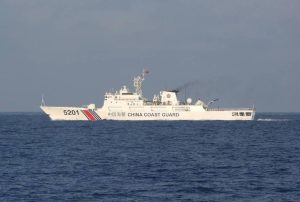The number of days Chinese government vessels were spotted in the contiguous zone of disputed islands in the East China Sea hit a record high in 2023. The China Coast Guard (CCG) also set a record for the number of vessels operating in the same waters around the Japanese-controlled but Chinese-claimed islands, which are known as the Senkaku Islands in Japan and the Diaoyu Islands in China.
Data released by the Japan Coast Guard (JCG) shows that Chinese government vessels entered the contiguous zone, which is 12 to 24 nautical miles (22 to 44 kilometers) from the coast, on 352 out of 365 days during last year. That’s the highest figure since record-keeping began in 2008, and an increase of 16 days compared with the previous record of 336 days set in 2022.
In 2023, a total of 1,287 Chinese government ships operated in the contiguous zone over 352 days, also setting a record high for the number of vessels involved, according to the JCG data.
In addition, Chinese government vessels maintained an uninterrupted presence in the contiguous zone for 134 successive days between August 5 and December 16 last year, their third-longest continued presence in these waters.
The record for a continued Chinese presence in the contiguous zone so far was set between February 13 and July 19 in 2021, a total of 157 successive days, followed by a stretch of 138 days in 2022.
The latest data suggests that Chinese government ships have been keeping up repeated incursions into waters around the contested, uninhabited islets for almost the entire year, except during bad weather such as typhoons.
More seriously, the data also shows that last year CCG ships repeatedly intruded into Japanese territorial waters on 42 days, the second highest number of days since 2013. Territorial waters are the areas within 12 nautical miles (22 kilometers) of island coasts.
In addition, four CCG vessels intruded into Japanese territorial waters surrounding the Senkaku/Diaoyu Islands for 80 hours and 36 minutes from March 30 to April 2 last year, the longest ever single intrusion since the Japanese government purchased three of the five islands from a private owner in 2012. The four ships continued to track Japanese fishing vessels in the waters.
The latest statistics came out as Chinese President Xi Jinping called for efforts to bolster Beijing’s sovereignty claim, with plans to keep its ships near the Japan-controlled islands for 365 days in 2024.
Japanese media reported late last month that Xi pointed out the need for Beijing to “constantly strengthen” its efforts to safeguard its sovereignty over the islands. The comments were made during a rare visit by Xi to the command office for the East China Sea area of the CCG in Shanghai on November 29.
“We can only move forward, not backward. We will never let even 1 millimeter of our territory be taken,” Xi was quoted as saying.
Most notably, Japan’s Kyodo news agency reported the CCG vessels will be charged with conducting on-site inspections of Japanese fishing vessels if necessary this year, citing unnamed sources.
Xi, who also heads the Central Military Commission, gave those directions soon after Japanese Prime Minister Kishida Fumio had directly conveyed to Xi his “serious concerns” about the situation in the East China Sea, including around the Senkaku/Diaoyu Islands, at a summit meeting with the Chinese leader in San Francisco on November 16.
It has become clear that the Chinese side is planning to strengthen its territorial claims to the islets through actual actions, despite Tokyo’s serious concerns over increased Chinese maritime activity.
Tokyo has been growing increasingly wary of Chinese military activities, especially those taking place near the Senkaku/Diaoyu Islands and Taiwan.
In Tokyo, Xi is known as a maritime politician rarely seen in Chinese history. For Xi, maritime interests have become the lifeblood of his political career. In his political career, Xi spent over 17 years in Fujian Province and nearly five years in Zhejiang Province on China’s east coast. He once allowed Wu Shengli, the commander-in-chief of the Chinese navy, to continue in his role even though he was supposed to retire.
Most recently, Xi appointed Dong Jun, a former top naval commander, as his new defense minister. It’s the first time a naval officer has been elevated to the post.
Xi is apparently trying to maintain the power of the Chinese Communist Party by appealing to maritime rights and interests in domestic politics, and also by leveraging territorial nationalism to influence domestic public opinion. In other words, the Senkaku/Diaoyu issue is closely intertwined with China’s domestic politics.
For this reason, Japan must continue to strengthen its surveillance capabilities against Chinese maritime activities, especially those taking place near the disputed islands and Taiwan.
The Senkaku/Diaoyu Islands sit about 170 kilometers northeast of Taiwan. The Japanese government sees China as trying to pressure Tokyo, as Japan becomes more involved in the Taiwan issue.
Looking back, China has claimed the Senkaku/Diaoyu Islands as its own territory in earnest since the 1970s, right after the United Nations Economic Commission for Asia and the Far East pointed out the possibility of oil reserves in the waters around the islands in 1969.
It is no longer an unusual sight to see Chinese government vessels in the waters surrounding the islands. At the same time, there are very few Japanese media reports about Chinese government vessels appearing around the Senkaku/Diaoyu Islands, perhaps because the Japanese media cannot find newsworthiness in a now-ordinary event. As a result, interest in the territorial sovereignty of the islands has appeared to ebb lower and lower in Japanese society.
All of this suggests that China’s “salami tactics,” which aim to take effective control of the Senkaku/Diaoyu Islands gradually, may be having an effect.































